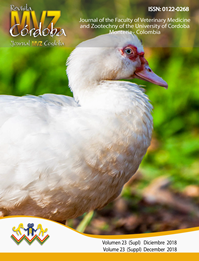Molecular characterization of Cryptococcus neoformans recovered from pigeon droppings in Rivera and Neiva, Colombia
Caracterización molecular de Cryptococcus neoformans recuperado de guano de palomas en Rivera y Neiva, Colombia
Show authors biography
Objective. Characterize phenotypically and genotypically isolates of Cryptococcus neoformans and Cryptococcus gattii that can be found in feces of pigeons (Columba livia) and in soil, leaves and detritus of almond trees (Terminalia catappa) in the municipalities of Neiva and Rivera, Colombia. Materials and methods. One hundred and eighteen samples were collected in 13 specific areas, characterized by the presence of almond trees and high density of birds, between January and June 2016. Incubation of the processed samples was done at 27°C for two weeks using Guizottia abyssinica agar. The phenotypic characterization, the species determination and the subsequent molecular typing was done using PCR fingerprinting with (GTG)5 primer and Restriction Fragment Length Polymorphism with URA5 and SJ01 primers. Results. A 5,9% of the samples from pigeon feces were positive for C neoformans var. grubii (VNI molecular pattern). Samples collected from almond tree detritus were not positive for any of the species studied. Conclusions. The isolation of C. neoformans from pigeon droppings in the municipalities of Rivera and Neiva adds to the scarce knowledge about this pathogen in the department of Huila, revealing the importance of continuing with these type of studies, not only in the environment but in the exposed population.
Article visits 1432 | PDF visits
Downloads
- Kwon-Chung KJ, Bennett JE, Wickes BL, Meyer W, Cuomo CA, Wollenburg KR, et al. The Case for Adopting the "Species Complex" Nomenclature for the Etiologic Agents of Cryptococcosis. Sphere 2017; 2(1): e00357-16. https://doi.org/10.1128/mSphere.00357-16
- Lucas S, Martins MdaL, Flores O, Meyer W, Spencer-Martins I, Inácio J. Differentiation of Cryptococcus neoformans varieties and Cryptococcus gatti using CAP59-based loop-mediated isothermal DNA amplification. Clin Microbiol Infec 2010; 16(6): 711-714. https://doi.org/10.1111/j.1469-0691.2009.02919.x
- Rosa G, Merlini LS, Bessi WH, Pires AP, Silva LZ, Perussi PR, et al. Survey of Cryptococcus neoformans in pigeon (Columbia livia) excreta in public Square in Umuarama, Paraná, Brazil. African J Microbiol Res 2016; 10(44): 1844-1844. https://doi.org/10.5897/AJMR2016.8253
- Rosario I, Acosta B, Colom MF. Pigeons and other birds as a reservoir for Cryptococcus spp. Rev Iberoam Micol 2008; 25(1): S13-8. https://doi.org/10.1016/S1130-1406(08)70020-2
- Escandón P, De Bedout C, Lizarazo J, Agudelo CI, Tobón Á, Bello S, et al. Cryptococcosis in Colombia: Results of the national surveillance program for the years 2006-2010. Biomédica 2012; 32(3): 386-98. https://doi.org/10.7705/biomedica.v32i3.707
- Escandón P, Montilla A. Tipificación molecular de aislamientos del complejo Cryptococcus neoformans/Cryptococcus gattii. Infectio 2010; 14(S2): S127-S130. https://doi.org/10.1016/S0123-9392(10)70130-2
- Cogliati M. Global molecular epidemiology of Cryptococcus neoformans and Cryptococcus gattii: An atlas of the molecular types. Scientifica 2013; 2013(1): 1-23. https://doi.org/10.1155/2013/675213
- Costa JJ, Freire AK, Aguiar R, Nogueira RS, Araújo FE, Collares DS, et al. Molecular methods for the diagnosis and characterization of Cryptococcus: A review. Can J Microbiol 2010; 56(6): 445-458. https://doi.org/10.1139/W10-030
- Mak S, Vélez N, Casta-eda E, Escandón P. Colombian Environmental Study Group. The Fungus among Us: Cryptococcus neoformans and Cryptococcus gattii Ecological Modeling for Colombia. J. Fungi 2015; 1(3): 332-344. https://doi.org/10.3390/jof1030332
- DANE. PROYECCIONES MUNICIPALES 2006-2020. [en línea]. 2008. URL Valida en: http://www.dane.gov.co/files/investigaciones/poblacion/conciliacenso/9ProyeccionesMunicipalesedadsexo.pdf.
- Escandón P, Sánchez A, Firacative C, Casta-eda E. Isolation of Cryptococcus gattii molecular type VGIII, from Corymbia ficifolia detritus in Colombia. MedMycol. 2010; 48(4):675–678. https://doi.org/10.3109/13693780903420633
- Casali AK, Goulart L, Rosa e Silva LK, Ribeiro AM, Amaral AA, Alves SH, et al. Molecular typing of clinical and environmental Cryptococcus neoformans isolates in the Brazilian state Rio Grande do Soul. FEMS Yeast Res. 2003; 3:405–415. https://doi.org/10.1016/S1567-1356(03)00038-2
- Meyer W, Casta-eda A, Jackson S, Huynh M, Casta-eda E. Molecular typing of Ibero American Cryptococcus neoformans isolates. Emerg Infect Dis. 2003; 9:189–195. https://doi.org/10.3201/eid0902.020246
- Quintero E, Casta-eda E, Ruiz A. Environmental distribution of Cryptococcus neoformans in the department of Cundinamarca-Colombia. Rev Iberoam Micol. 2005; 22(2):93-98. https://doi.org/10.1016/S1130-1406(05)70015-2
- Callejas A, Ordo-ez N, Rodriguez MC, Casta-eda E. First isolation of Cryptococcus neoformans var. gattii, serotype C, from the environment in Colombia. Med Mycol. 1998; 36(5):341-4. https://doi.org/10.1046/j.1365-280X.1998.00159.x
- Agudelo-gonzales S, Murcia-Sanchez F, Salinas D, Osorio J. Infecciones oportunistas en pacientes con VIH en el hospital universitario de Neiva, Colombia, 2007-2012. Infectio. 2015; 19(2):52-59. https://doi.org/10.1016/j.infect.2014.11.008
























